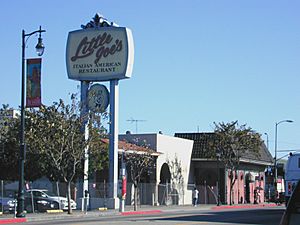Little Joe's facts for kids
Quick facts for kids Little Joe's Italian American Restaurant |
|
|---|---|

The former Little Joe's Italian American Restaurant
|
|
| Restaurant information | |
| Established | 1928 |
| Closed | 1998 |
| Food type | Italian-American |
| Street address | 904 North Broadway |
| City | Los Angeles |
| County | Los Angeles |
| State | California |
| Postal/ZIP code | 90012 |
| Country | United States |
| Coordinates | 34°3′51″N 118°14′13″W / 34.06417°N 118.23694°W |
Little Joe's Italian American Restaurant was a famous Italian restaurant in Los Angeles, California. It was located in the Chinatown area, at the corner of Broadway and College Street. This part of the city used to be home to many Italian American families before Chinatown was built.
Contents
History of Little Joe's Restaurant
Early Beginnings as a Grocery Store
The story of Little Joe's began with Charles Viotto, who was born in Italy. He opened a grocery store in Los Angeles. His daughter, Mary, married Robert Nuccio. In 1895, Robert took over the store. He changed its name to The Italian-American Grocery Company.
In 1923, Robert Nuccio traveled to Italy with his children, Chel and John. He wanted to convince his family to move to America. Before leaving, he sold the grocery store to his friends, John Gadeschi and Joe Vivalda. They moved the store to North Broadway in 1927.
From Grocery to Restaurant Business
When Union Station was being built nearby, many Italian workers came to the grocery store for lunch. John Gadeschi started making sandwiches for them. The workers were a bit noisy, which made some women shoppers uncomfortable. So, John and Joe decided to open a restaurant right next door. This way, the men could eat their lunch without disturbing the women who were shopping.
During World War II, many Italian businesses in the United States changed their names. This was because Italy was on the side of the Axis powers. For example, the Bank of Italy became Bank of America. The Italian-American Grocery Company also changed its name to Little Joe's. It was named after Joe Vivalda. This restaurant was not connected to any other restaurant with the same name.
Family Takes Over the Business
Later, John Gadeschi's daughter, Marion, married John Albert Nuccio. John Albert was Robert Nuccio's son. This brought the Nuccio family back into the restaurant business. John Albert had been studying law at USC before the war. After serving in World War II, he started working with his father-in-law at the restaurant.
The Nuccio family continued to own and run Little Joe's until it closed in 1998. At the time it closed, the restaurant was managed by the third generation of Nuccio men: Steve, Bob, and Jay. Jay later left to open his own place, The Crazy Horse, a country-and-western bar and eatery in West Covina. This left Steve and Bob to manage Little Joe's.
Why Little Joe's Closed Down
The restaurant closed its doors in December 1998. The owners had hoped that the Chinatown and Downtown areas would become popular places for evening dining. However, this did not happen as they had hoped. The owners decided it was time to retire. Other nearby areas, like Old Pasadena, became very popular. This made it hard for restaurants in downtown Los Angeles to attract evening diners.
New Plans for the Restaurant Site
As part of an effort to improve Chinatown, there were plans to build new shops, homes, and a large parking garage where the restaurant stood. On December 2, 2013, a company called Forest City Enterprises began tearing down Little Joe's. This was to start building a new $100 million project called Blossom Plaza. This project had been planned for over ten years. It would include a five-story apartment building above shops at ground level. The old restaurant building, which had been empty for a long time, was completely torn down by January 17, 2014.
Discovery of the Zanja Madre
When workers started digging for the Blossom Plaza project, they found something very old. They discovered a 100-foot-long section of the Zanja Madre. This was the original water main for the early city of Los Angeles. It carried water from the Los Angeles River, near what is now Griffith Park, to the first residents of the city.

